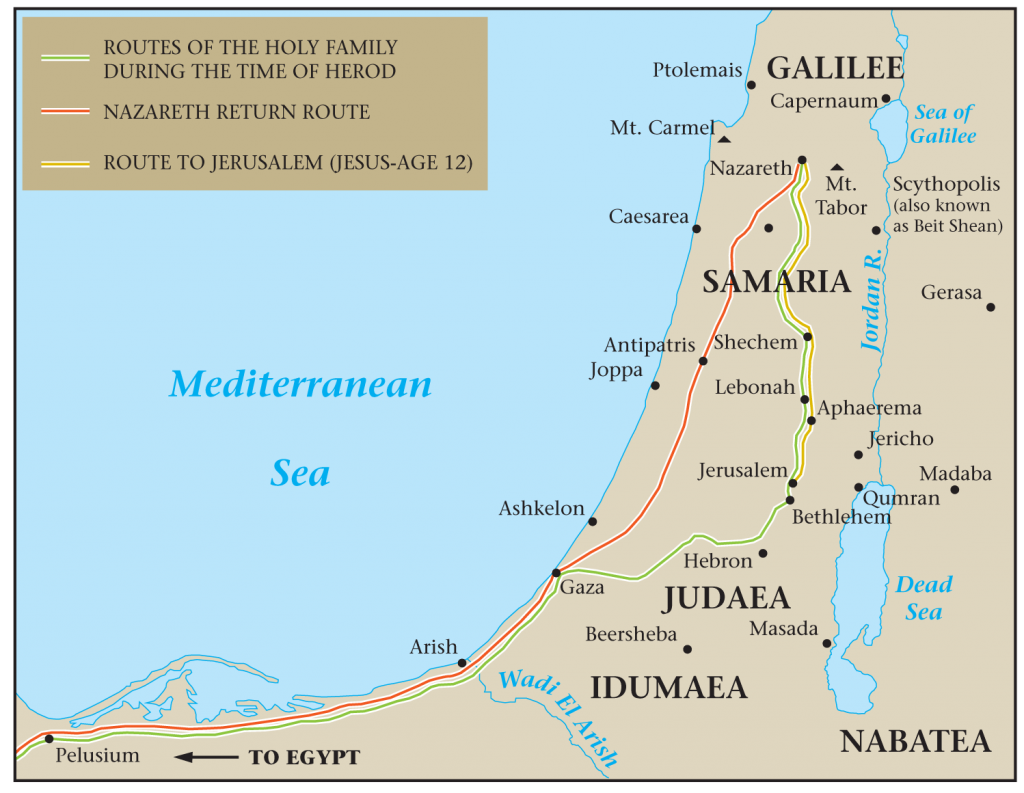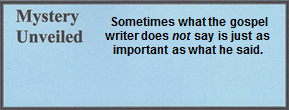04.05.02 Mt. 2:13-15 Egypt
ESCAPE TO EGYPT
13 After they were gone, an angel of the Lord suddenly appeared to Joseph in a dream, saying, “Get up! Take the child and His mother, flee to Egypt, and stay there until I tell you. For Herod is about to search for the child to destroy Him.” 14 So he got up, took the child and His mother during the night, and escaped to Egypt. 15 He stayed there until Herod’s death, so that what was spoken by the Lord through the prophet might be fulfilled: Out of Egypt I called My Son. (Hosea 11:1)
The first thought of Egypt by Bible students is that it was the land of Israelite slavery. But for centuries it had been a place of refuge. Even Jeremiah was there for a while. In fact, some cities, such as Alexandria, had a significant Jewish population by the first century B.C.[1] Trade and commerce was brisk between Egypt and Israel, but Herod constantly feared his throne would be challenged by a number of conspirators.
Joseph received his second dream. Certainly he knew the stories of the Egyptian Pharaoh, Haman, and Antiochus IV Epiphanes, and others who tried to wipe out the Jewish people. “So he got up … during the night and escaped to Egypt.” Joseph took Mary and Jesus and fled to Egypt due to the warning given by the angel. In all probability, they took the small connector road from Bethlehem to the Ridge Route to the coastal Via Maris and then went on to Egypt. Traveling alone was extremely dangerous,[2] especially with the gifts given to them by the magi. But if an angel warned them about the impending danger of Herod, that messenger certainly would have provided all the protection they needed in their journey. After three days’ journey from Bethlehem, they reached the Rhinokolura Wadi (modern Wadi al-Arish),[3] which was the border between Egypt and Judea. Once they crossed the seasonal riverbed, they continued their journey without fear from Herod.[4]
04.05.02.Q1 Where in Egypt did Mary, Joseph, and Jesus go?
Their place of residency has been lost in history, but two possible cities have been suggested.
- Alexandria, built by Alexander the Great, was a major Jewish center. It was larger than any city in Judea, with an estimated forty percent Jewish population. It had a synagogue so huge that a courier was needed to repeat the words of the rabbi so the people in the back of the auditorium could hear. It was in this city where the Hebrew Scriptures had been translated into Greek some two and a half centuries earlier. Joseph could have quickly found a home and employment there as a young carpenter, although the funds provided by the magi most certainly would have been sufficient. While Alexandria would have been an ideal city for them, it is also further west than many other Jewish communities. Therefore, it seems rather unlikely Mary and Joseph would have traveled so far to the western side of the Nile.[5]
- The second opinion is a popular tradition that the Holy Family lived in the Old Coptic Quarter of the city of Old Cairo. It is where legend says the Church of St. Sergiust marks the traditional site where Mary and Joseph lived for three months. Coptic Christians for centuries claimed that it was there, in a crypt that was originally a cave or grotto that the infant Jesus was laid to rest. However, there is a problem with this traditional site. Cairo was not founded until A.D. 641, and then it was simply a military outpost. Eventually a town known as al-Fustat grew around the outpost and was later renamed Cairo. Just as the Holy Land has its share of legends, so does Egypt. So this is hardly a serious contender for where Mary and Joseph could have stayed. Where the Holy Family resided in Egypt is known only to God.

04.05.02.Z A MAP OF THE HOLY FAMILY’S ROUTE TO/FROM EGYPT. Map of the routes likely taken by Joseph, Mary and Jesus from Nazareth to Bethlehem, to Egypt, and their return to Nazareth. When they crossed the “River of Egypt,” known today as the Wadi of Egypt, or Wadi El Arish (1 Kgs. 8:65) and entered Egypt, they were safe from Herod’s army. Courtesy of International Mapping and Dan Przywara.
A Lesson in First Century Hermeneutics:
04.05.02.X Use Of A Double Reference[6]
“Out of Egypt I called my son.” This is not so much a prophecy by Hosea concerning the return of Jesus from Egypt, as it is a double reference to the historical deliverance of the Jewish people out of Egyptian bondage (Ex. 4:22). Yet the meaning of the prophet’s words is said to be confusing because there is no mention of a messiah. The verse reads as follows:
When Israel was a child, I loved him,
and out of Egypt I called My son.
Hosea 11:1
A preacher once clarified the meaning with a riddle. He told the congregation to listen (or read) the following five points and guess who the subject is.
- Without a miracle in his mother’s womb he would never have been born.
- As an infant he was taken to Egypt.
- He returned from Egypt to the Promised Land.
- He saw signs and wonders, and the hand of God moved for him.
- He was killed by his enemies, rose from death, and will live forever into eternity.
Nearly everyone immediately identified the subject as Jesus. However, the riddle was intended to describe the nation of Israel. He noted these similarities:
- Without a divine intervention beginning with Abraham, the Jewish nation would never have been born.
- When a deadly famine fell upon the land of Canaan, the fledgling nation of less than a hundred souls went to Egypt.
- In God’s timing, they returned from Egypt to the Promised Land (Canaan).
- As they left Egypt, they witnessed profound signs and wonders that demonstrated the hand of God for all nations to see.
- In A.D. 70 the Roman armies killed national Israel, but in 1948 the nation was reborn and will live forever into eternity.
Theologians call this type of genre of Hosea 11:1 a “double reference,” that is, it describes both the life of national Israel and the life of Jesus. Matthew recognized the history of the Hebrew children as a “type and shadow” of Jesus.[7] But the imagery goes further: Just as God through Moses led His people out of Egyptian bondage and to the border of the Promised Land, so Jesus would lead His people out of the bondage of sin and into the Kingdom of God.[8] In fact, all dealings God had with His people in the Old Testament Period were in some manner preparatory for the coming Messiah. Jesus is the realization and fulfillment of their salvation. The Gentiles are privileged to be grafted into these blessings of Abraham (Rom. 9-11). However, sometimes it is what the gospel writer does not say that is significant. Notice verse 2 of this Hosea’s passage.
1 When Israel was a child, I loved him,
and out of Egypt I called My son.
2 The more they (the prophets) called them (the people of Israel),
the more they (these people) departed from Me.
Hosea 11:1-2
When the Israelite children entered Egypt, they went as a clan; a family. When they left, they did so as a nation. When Mary, Joseph and the infant Jesus entered Egypt, they entered as a family, but they they left, a new nation was about to be born. Not only were the people of ancient Israel a “type and shadow” of Jesus, but just as they once rejected the authority of Moses and Joshua (verse 2a), so likewise, they rejected Jesus. The first century readers of Matthew’s gospel never missed this important point. Matthew expected his Jewish audience to know this passage and, in essence said, what happened to Israel happened to Jesus.

[1]. Some historians have estimated the Jewish population of Alexandria, Egypt, to have been about 250,000 at the time of Christ.
[2]. Josephus, Antiquities 20.6.1(118); Wars 2.15.6 (232).
[3]. Lightfoot, A Commentary on the New Testament from the Talmud and Hebraica. 1:205. See “Wadi” in Appendix 26.
[4]. Farrar, Life of Christ. 17.
[5]. Maier, In the Fullness of Time. 73.
[6]. See “The Law Of Double Reference.” (Part 1, No. 6) in Appendix 30.
[7]. See “Type and Shadow” in Appendix 26 and “The Law Of Typological Interpretation Of Prophetic Words” (Part 1, No. 5) in Appendix 30.
[8]. Pentecost, The Words and Works of Jesus Christ. 70.